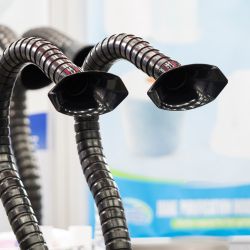
Testing a fume extractor is a crucial step in ensuring its optimal performance and effectiveness in removing harmful fumes and contaminants from the air.
By conducting thorough tests, you can verify that the fume is functioning as intended, maintain a safe working environment, and comply with safety regulations.
This unique guide will provide you with a comprehensive introduction to testing a fume extractor, outlining the key steps involved and highlighting important considerations.
Whether you are setting up a new fume extractor or assessing the performance of an existing one, this guide will equip you with the knowledge to conduct reliable and informative tests.
Testing a fume extractor involves more than simply switching it on and observing airflow. It requires careful evaluation of key performance indicators, such as airflow velocity, capture efficiency, and filtration effectiveness.
Additionally, Fume extractor understanding the specific requirements of your workspace and the contaminants being generated is crucial for accurate testing.
This guide will walk you through the testing process, covering both basic and advanced techniques, to ensure comprehensive evaluation and validation of your fume extractor’s performance.
By following these testing procedures, you can maintain a healthy and safe work environment, protect the well-being of workers, and comply with industry standards and regulations.
How do you test a fume extractor
This guide aims to provide a comprehensive understanding of how to test a fume extractor effectively. By following the steps outlined in this guide, you can identify any issues, troubleshoot problems, and ensure that your fume extractor is operating at its best. For more information visit here.
Importance of Testing a Fume Extractor
Ensuring Air Quality and Worker Safety
Explain the critical role of a fume extractor in maintaining clean air and protecting workers from harmful fumes and contaminants.
Identifying Performance Issues
Highlight the importance of regular testing to detect any potential performance issues or malfunctions in the fume extractor.
Compliance with Safety Regulations
Emphasize that regular testing is necessary to meet safety regulations and ensure that the fume extractor is functioning within specified standards.
Preparing for Testing
Familiarize Yourself with the Fume Extractor: Understand the different components of the fume , including the filters, fan, motor, and control panel.
Review Manufacturer’s Instructions
Read the manufacturer’s manual or guidelines to familiarize yourself with specific testing procedures and recommendations.
Gather Required Tools and Equipment
Assemble the necessary tools and equipment for testing, such as an anemometer or velometer, a smoke source, a sound level meter, and any other relevant testing devices.
Visual Inspection, Airflow Testing, Smoke Testing, Noise Level Testing, Odor Testing Provide detailed step-by-step instructions for each of these sections, including specific testing methods, recommended tools, and measurements.
Performance Evaluation
Comparing Test Results to Specifications
Explain the importance of comparing the test results to the specifications provided by the manufacturer to determine if the fume is operating within acceptable parameters.
Analyzing Deviations or Inconsistencies
Guide readers on how to interpret the test results and identify any deviations or inconsistencies that may indicate performance issues.
Documenting Test Results
Emphasize the importance of documenting the test results for future reference and comparison during subsequent tests.
Troubleshooting and Maintenance, Regular Testing Schedule, Conclusion Provide detailed information on troubleshooting performance issues, establishing a regular testing schedule, and summarize the key points discussed in the guide.
Conclusion
Regularly testing a fume extractor is essential to ensure its optimal performance, maintain air quality, and protect workers’ health and safety.
By following the step-by-step instructions in this guide, you can effectively test your fume , identify any performance issues, and take appropriate measures for maintenance and troubleshooting.
Remember that maintaining a safe work environment is an ongoing process, and regular testing should be integrated into your overall maintenance routine.

